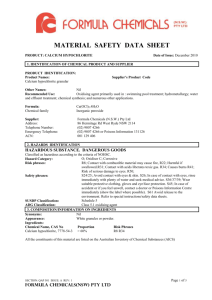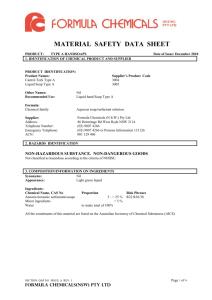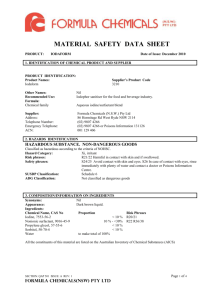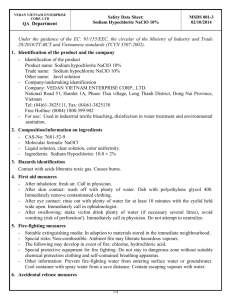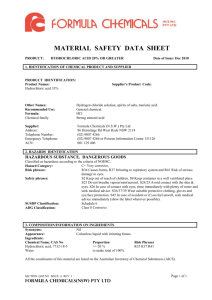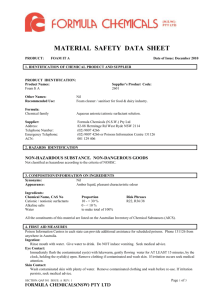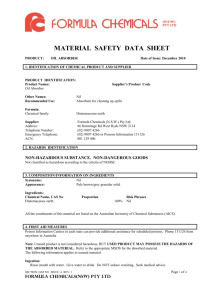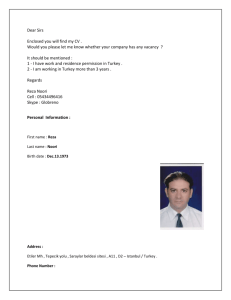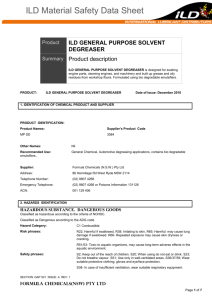Sodium Hypochlorite MSDS: Safety & Handling Guide
advertisement
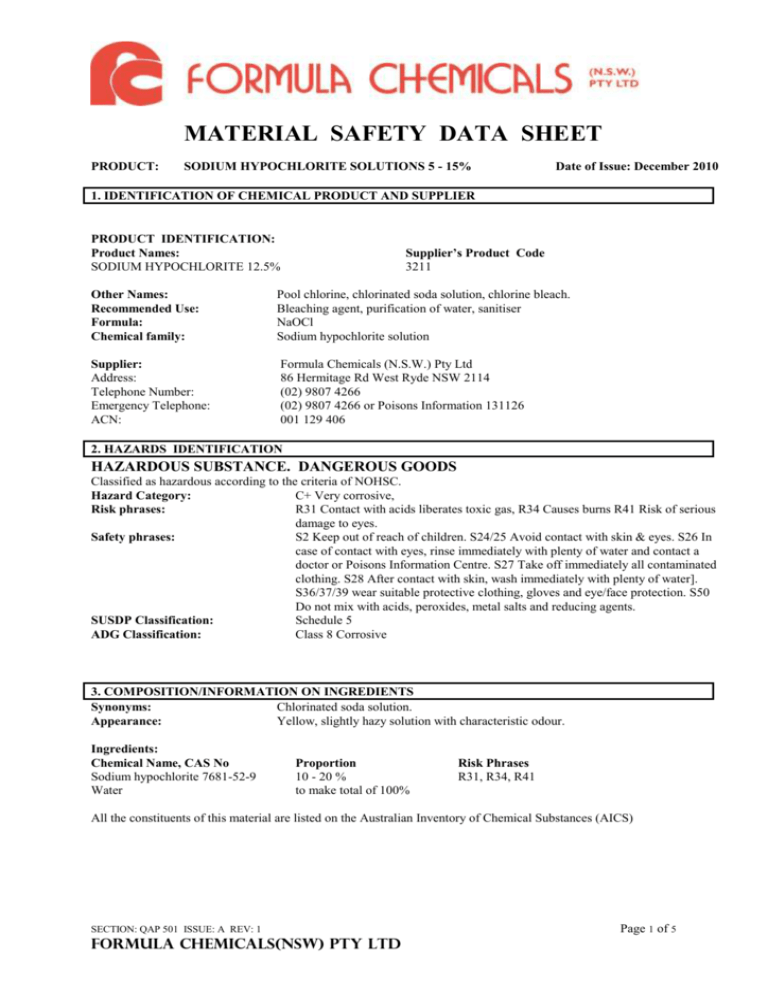
MATERIAL SAFETY DATA SHEET PRODUCT: SODIUM HYPOCHLORITE SOLUTIONS 5 - 15% Date of Issue: December 2010 1. IDENTIFICATION OF CHEMICAL PRODUCT AND SUPPLIER PRODUCT IDENTIFICATION: Product Names: SODIUM HYPOCHLORITE 12.5% Supplier’s Product Code 3211 Other Names: Recommended Use: Formula: Chemical family: Pool chlorine, chlorinated soda solution, chlorine bleach. Bleaching agent, purification of water, sanitiser NaOCl Sodium hypochlorite solution Supplier: Address: Telephone Number: Emergency Telephone: ACN: Formula Chemicals (N.S.W.) Pty Ltd 86 Hermitage Rd West Ryde NSW 2114 (02) 9807 4266 (02) 9807 4266 or Poisons Information 131126 001 129 406 2. HAZARDS IDENTIFICATION HAZARDOUS SUBSTANCE. DANGEROUS GOODS Classified as hazardous according to the criteria of NOHSC. C+ Very corrosive, Hazard Category: R31 Contact with acids liberates toxic gas, R34 Causes burns R41 Risk of serious Risk phrases: damage to eyes. S2 Keep out of reach of children. S24/25 Avoid contact with skin & eyes. S26 In Safety phrases: case of contact with eyes, rinse immediately with plenty of water and contact a doctor or Poisons Information Centre. S27 Take off immediately all contaminated clothing. S28 After contact with skin, wash immediately with plenty of water]. S36/37/39 wear suitable protective clothing, gloves and eye/face protection. S50 Do not mix with acids, peroxides, metal salts and reducing agents. Schedule 5 SUSDP Classification: Class 8 Corrosive ADG Classification: 3. COMPOSITION/INFORMATION ON INGREDIENTS Synonyms: Chlorinated soda solution. Appearance: Yellow, slightly hazy solution with characteristic odour. Ingredients: Chemical Name, CAS No Sodium hypochlorite 7681-52-9 Water Proportion 10 - 20 % to make total of 100% Risk Phrases R31, R34, R41 All the constituents of this material are listed on the Australian Inventory of Chemical Substances (AICS) SECTION: QAP 501 ISSUE: A REV: 1 FORMULA CHEMICALS(NSW) PTY LTD Page 1 of 5 FORMULA CHEMICALS(NSW) PTY LTD SODIUM HYPOCHLORITE SOLUTIONS 5 - 15% Date of Issue: December 2010 4. FIRST AID MEASURES Poison Information Centres in each state can provide additional assistance for scheduled poisons. Phone 131126 from anywhere in Australia Ingestion: Never give anything by mouth if victim is rapidly losing consciousness, or is unconscious or convulsing. Rinse mouth thoroughly with water. Do NOT induce vomiting. If victim can swallow, have him/her drink 250 to 300 mL of water to dilute material in stomach. If vomiting occurs naturally, have victim lean forward to reduce risk of aspiration. Repeat administration of water. Obtain medical attention immediately. Eye Contact: SPEED IS ESSENTIAL. Immediately flush the contaminated eye(s) with lukewarm, gently flowing water for AT LEAST 15 minutes, by the clock, holding the eyelid(s) open. Take care not to rinse contaminated water into the nonaffected eye. If irritation persists, repeat flushing. If available, a neutral saline solution may be used to flush the contaminated eye(s) an additional 30 minutes. Obtain medical attention immediately. Skin Contact: First aiders avoid direct contact with this chemical. As quickly as possible, flush contaminated area with lukewarm, gently running water for at least 30 minutes, by the clock. Under running water, remove contaminated clothing, shoes, and leather goods (e.g. watchbands, belts). If irritation persists, repeat flushing. Obtain medical attention immediately. Completely decontaminate clothing, shoes and leather goods before re-use or discard. Inhalation: Remove source of contamination or move victim to fresh air. Obtain medical advice immediately. Other First Aid: Provide general supportive measures (comfort, warmth, rest). Consult a physician and/or the nearest Poison Control Centre for all exposures except minor instances of inhalation contact. Notes to physician: Treat symptomatically as for strong alkalis. Do not use acid antidotes 5. FIRE FIGHTING MEASURES Specific hazards: Non-combustible material Fire fighting further advice: Not combustible. Can decompose with heat liberating toxic fumes, including chlorine gas. If safe to do so, remove containers from path of fire. Fire fighters to wear self contained breathing apparatus and protective clothing. Contact with acids may release toxic gas (chlorine) Suitable Extinguishing media: Water fog (or if unavailable fine water mist or spray), foam, dry agent (carbon dioxide, dry chemical powder) 6. ACCIDENTAL RELEASE MEASURES Small Spills: Wear personal protective equipment. Contain using sand or diatomaceous earth. Collect and seal in properly labelled drums. Wash remaining area with large volumes of water. Large Spills: PRECAUTIONS Restrict access to area. Clear area of unprotected personnel. Provide adequate protective equipment and ventilation. Remove chemicals which can react with the spilled material. Spills are slippery. CLEANUP Contain spill or leak. Do not allow entry into sewers or waterways. Spilled solutions should be contained by dyking with inert material, such as sand or earth. Solutions can be recovered or carefully diluted with water. Do not neutralize with acids due to possible release of toxic chlorine gas. DISPOSAL Federal, state and local regulations should be reviewed prior to disposal. May be possible to neutralise with sodium thiosulphate or sodium metabisulfite under controlled conditions, avoiding acid conditions, dilute and flush the material into a sewer. May be possible to atomise dilute solutions in an approved combustion chamber. Harmful to aquatic life in high concentrations. 7. HANDLING AND STORAGE HANDLING Avoid generating mist or spray. When diluting solution, add material to water. Label containers. Keep containers closed when not in use. Empty containers may contain residues which are hazardous. Use smallest possible amounts in designated areas with adequate ventilation. Have emergency equipment (for fires, spills, leaks, etc.) readily available. SECTION: QAP 501 ISSUE: A REV: 1 FORMULA CHEMICALS(NSW) PTY LTD Page 2 of 5 FORMULA CHEMICALS(NSW) PTY LTD SODIUM HYPOCHLORITE SOLUTIONS 5 - 15% Date of Issue: December 2010 STORAGE CONDITIONS Materials that react violently with sodium hypochlorite should not be stored in the same area. Use corrosion-resistant structural materials and lighting and ventilation systems in the storage area. Store in suitable labelled containers. Keep containers tightly closed when not in use and when empty. Protect from damage. Containers made of inert plastics or nickel alloys are preferred. Storage tanks should be above ground and surrounded with dykes capable of holding entire contents. Limit quantity of material in storage. Restrict access to storage area. Post warning signs when appropriate. Keep storage area separate from populated work areas. Inspect periodically for deficiencies such as damage or leaks. Class 8 goods are not to be loaded with classes 1, 4.3, 5.1, 5.2, 6*, 7, or foodstuffs or foodstuff empties. * when class 6 is a cyanide and class 8 is an acid. 8. EXPOSURE CONTROLS/PERSONAL PROTECTION Exposure Standards: (Chlorine - decomposition product) 3 mg/m3, peak, NOHSC Australia. Engineering Controls: Maintain concentration below recommended exposure limit. Engineering control methods to reduce hazardous exposures are preferred. General methods include mechanical ventilation, (dilution and general exhaust), process or personnel enclosure, control of process conditions and process modification (e.g. substitution of a less hazardous material). Administrative controls and personal protective equipment may be also required. Use a corrosion-resistant ventilation system separate from other exhaust ventilation systems. Exhaust directly to the outside. Use local exhaust ventilation, and process enclosure if necessary, to control airborne spray / mists. Supply sufficient air to make up for air removed by exhaust systems. Personal Protection: RESPIRATORY PROTECTION : If engineering controls and work practices are not effective in controlling exposure to this material, then wear suitable personal protective equipment including approved respiratory protection. Have appropriate equipment available for use in emergencies such as spills or fire. If respiratory protection is required, institute a complete respiratory protection program including selection, fit testing, training, maintenance and inspection. EYE/FACE PROTECTION Splash proof chemical safety goggles. A face shield may also be necessary. SKIN PROTECTION Impervious gloves, coveralls, boots and/or other resistant protective clothing. Have a safety shower/eye-wash fountain readily available in the immediate work area. NOTE: Resistance of specific materials can vary from product to product. Evaluate resistance under conditions of use and maintain clothing carefully. PERSONAL PROTECTION COMMENTS Remove contaminated clothing promptly. Keep contaminated clothing in closed containers. Discard or launder before rewearing. Inform laundry personnel of contaminant's hazards. Do not eat, drink or smoke in work areas. Wash hands thoroughly after handling this material. Maintain good housekeeping. 9. PHYSICAL & CHEMICAL PROPERTIES Appearance: Yellow slightly hazy solution with distinctive odour. Odour threshold: Specific Gravity: Flash Point: Flammability limits PH (1% solution) Solubility in water: Not available approx 1.2 Non-combustible (does not burn) Non-flammable 12 Completely soluble 10. STABILITY AND REACTIVITY INCOMPATIBILITY -MATERIALS TO AVOID: STRONG ACIDS - may react violently & release toxic chlorine gas. METALS - reaction may produce flammable and explosive hydrogen gas. PEROXIDES REDUCING AGENTS METAL SALTS HAZARDOUS DECOMPOSITION PRODUCTS Chlorine gas HAZARDOUS POLYMERIZATION Does not occur CORROSIVITY TO METALS Corrosive to aluminium, tin, zinc. Corrosive to steel at elevated temperatures. Fire/Explosion Hazard: EXPLOSION DATA - SENSITIVITY TO MECHANICAL IMPACT Not applicable SECTION: QAP 501 ISSUE: A REV: 1 FORMULA CHEMICALS(NSW) PTY LTD Page 3 of 5 FORMULA CHEMICALS(NSW) PTY LTD SODIUM HYPOCHLORITE SOLUTIONS 5 - 15% Date of Issue: December 2010 EXPLOSION DATA - SENSITIVITY TO STATIC CHARGE Not applicable FIRE HAZARD COMMENTS Will not burn or support combustion. However, reaction with a number of commonly encountered materials (see Chemical Reactivity) can generate sufficient heat to ignite nearby combustible materials. FIRE EXTINGUISHING AGENTS Use an extinguisher appropriate to the material which is burning FIRE FIGHTING PROCEDURES Water can be used to extinguish a fire in an area where product is stored. COMBUSTION PRODUCTS None Fire fighters to wear full body protective clothing with breathing apparatus. 11. TOXICOLOGICAL INFORMATION Acute Effects: Ingestion: Should ingestion occur, severe pain; burning of the mouth, throat and oesophagus; vomiting; diarrhoea; collapse and possible death may result. Eye contact: A severe eye irritant. Can penetrate deeply causing irritation or severe burns depending on the concentration and duration of exposure. In severe cases, ulceration and permanent damage may occur. Skin contact: Corrosive. Capable of causing burns. Corrosion will continue until removed. Severity depends on concentration and duration of exposure. Burns are not immediately painful; onset of pain may be minutes to hours. Inhalation: Irritation of the nose, throat and lungs would occur due to the corrosive nature of sodium hypochlorite. However, there are no actual reports of industrial workers exposed to sodium hypochlorite experiencing these symptoms. Long term Effects: HEALTH EFFECTS There have been no documented effects due to long-term exposure to product. Repeated or prolonged skin contact can cause chronic contact dermatitis. Toxicity Data: Oral LD50 (rat) 8910 mg/kg. More detailed information about the effects of chemicals on health can be obtained from NOHSC Australia. 12. ECOLOGICAL INFORMATION Avoid contaminating waterways. 13. DISPOSAL CONSIDERATIONS Refer to State Land Waste Management Authority. Decontaminate empty containers before disposal, by triple rinsing with water, using rinse water in further processing or neutralize rinse water. 14. TRANSPORT INFORMATION UN No: Proper shipping name: Class: Packing Group: Hazchem Code: EPG Segregation Dangerous Goods 1791 HYPOCHLORITE SOLUTIONS 8 3 2X 8A1 not to be loaded with classes 1, 4.3, 5.1, 5.2, 6, 7, class 8 strong acids or foodstuffs or foodstuff empties. 15. REGULATORY INFORMATION Classified as hazardous according to the criteria of NOHSC, Schedule 5 poison according to SUSDP, Class 8 according to ADG R-phrases: R31 Contact with acids liberates toxic gas, R34 Causes burns, R41 Risk of serious damage to eyes. SECTION: QAP 501 ISSUE: A REV: 1 FORMULA CHEMICALS(NSW) PTY LTD Page 4 of 5 FORMULA CHEMICALS(NSW) PTY LTD SODIUM HYPOCHLORITE SOLUTIONS 5 - 15% Date of Issue: December 2010 S-phrases: S2 Keep out of reach of children. S24/25 Avoid contact with skin & eyes. S26 In case of contact with eyes, rinse immediately with plenty of water and contact a doctor or Poisons Information Centre. S27 Take off immediately all contaminated clothing. S28 After contact with skin, wash immediately with plenty of water]. S36/37/39 wear suitable protective clothing, gloves and eye/face protection. S50 Do not mix with acids, peroxides, metal salts and reducing agents. 16. OTHER INFORMATION References: (1) National Code of Practice for the preparation of MSDS [NOHSC:2011(2003), (2) List of Designated Hazardous Substances [NOHSC:10005:1999] (3) ADG Code 6th Edition (4) Orica Chemicals Sodium hypochlorite MSDS issued Feb 1999 Contact Point: Quality Assurance Manager Tel (02) 9807 4266 DISCLAIMER: All information given in this data sheet and by the company's technical staff is compiled from the best information currently available to the company. The company accepts no responsibility whatsoever for its accuracy or for any results which may be obtained by customers. Any customer who relies upon any advice or information given in this data sheet by the company or by its technical staff does so entirely at its own risk, and the company will not be liable for any loss or damage thereby suffered notwithstanding any want of care on the part of the company or its staff in compiling or giving the advice or information. SECTION: QAP 501 ISSUE: A REV: 1 FORMULA CHEMICALS(NSW) PTY LTD Page 5 of 5
